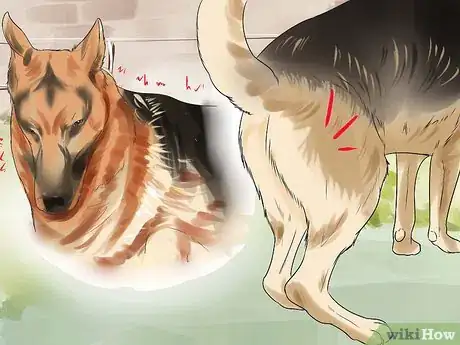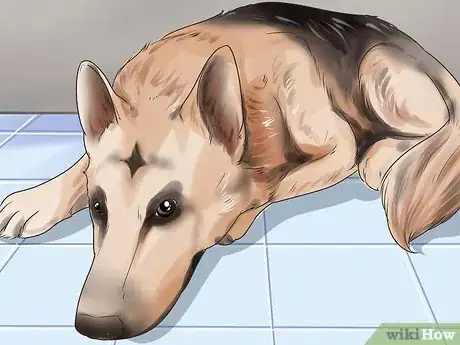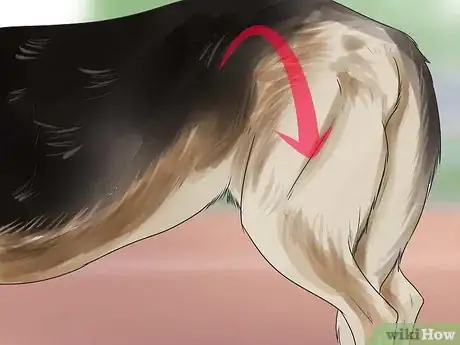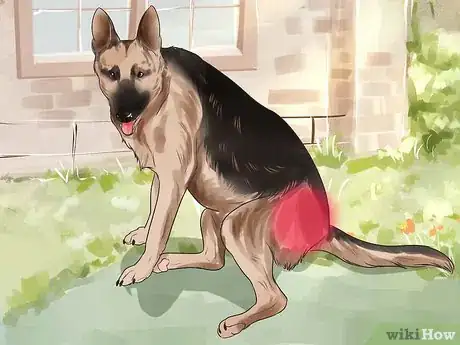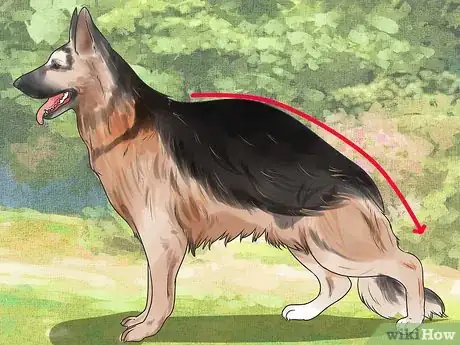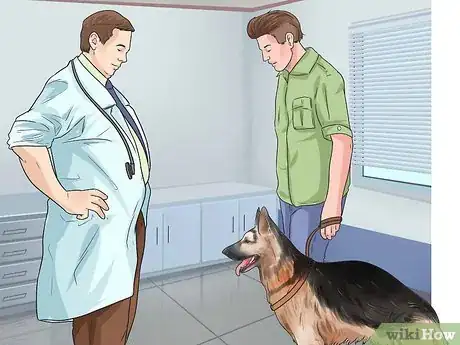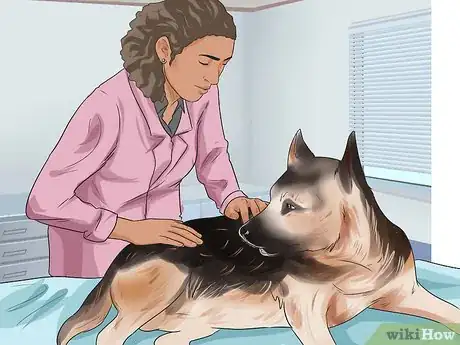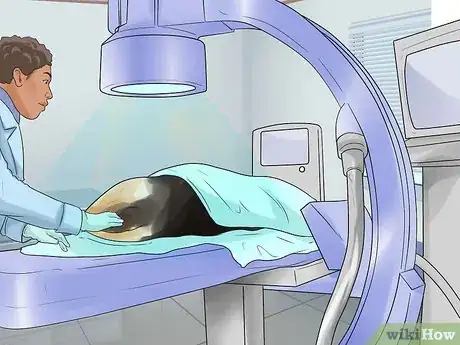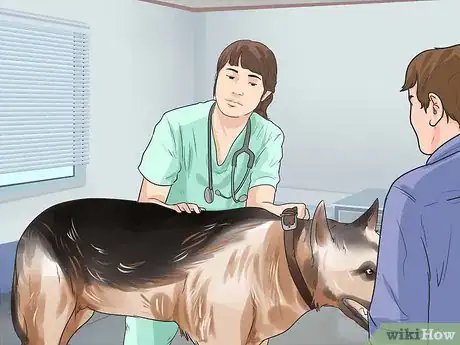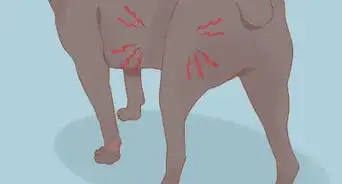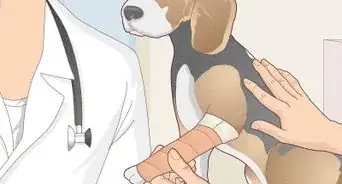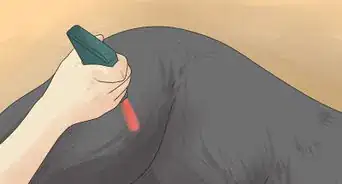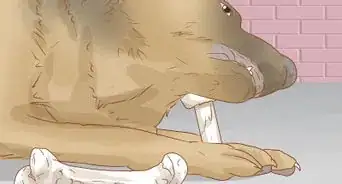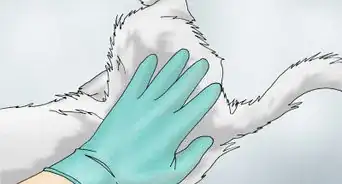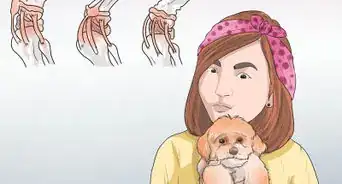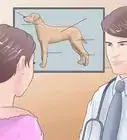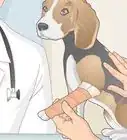This article was co-authored by Pippa Elliott, MRCVS. Dr. Elliott, BVMS, MRCVS is a veterinarian with over 30 years of experience in veterinary surgery and companion animal practice. She graduated from the University of Glasgow in 1987 with a degree in veterinary medicine and surgery. She has worked at the same animal clinic in her hometown for over 20 years.
There are 7 references cited in this article, which can be found at the bottom of the page.
This article has been viewed 25,017 times.
Hip dysplasia is an abnormality of the hip joints. The German shepherd unfortunately has a genetic tendency to developing hip dysplasia.[1] Hip dysplasia ranges in severity from mild to severe, and in the worst cases has the potential to disable an otherwise active dog. If you have a German shepherd, it is important to be aware of the signs and get your pet checked by a veterinarian if you suspect hip dysplasia.
Steps
Recognizing the Symptoms of Hip Dysplasia
-
1Watch for pain in the hips. A common sign of hip dysplasia is painful hips. You may hear whining when your dog walks, or see a decreased level of activity.
- Your dog may have a tendency to rest the sore leg when standing. He may also move back on forth from one leg to the other.
- Some dogs may react aggressively if you go to stroke or touch the hip area because of pain.
- In young dogs, the first sign of pain might be that the German shepherd has difficulty climbing stairs or jumping into a car. They may also not be able to run and exercise freely, as you would expect in a young dog.
-
2Look for lameness affecting the back end. Dogs can present at a young age, from six to 12 months, with sudden back end lameness. Other dogs may not present until they are middle aged as their mobility gradually worsens as they age. The lameness may be worse after periods of exercise.[2]
- Lameness can affect just one leg if one side is worse or both back legs.
- Your dog may stand with a markedly dropped back end. He may also move in a bunny-hop manner, swinging both back legs forward as the same time instead of moving them independently.[3] [4]
- If your dog is an older dog, he may walk with a limp.
Advertisement -
3Check for muscle atrophy. When you look at your dog from behind, you may notice there is muscle wastage on the most severely affected leg. You may also notice muscle atrophy of the thighs.[5]
- Because of this, the shoulder muscles may be larger because they will take up the slack.
-
4Monitor for movement hesitation or reluctance. Your dog may hesitate before he moves his back legs. For example, he may hesitate or take longer to push himself up when he’s sitting on his back legs. He may also hesitate to run or jump.[6]
- Your dog may have trouble squatting when he goes to the bathroom. He may also fall over when trying to use the bathroom.[7]
-
5Look for narrow hips. Many dogs with hip dysplasia have narrow hips, and their back legs are spaced extremely close together.[8]
Diagnosing Hip Dysplasia
-
1Take your German shepherd to the vet. If you notice that your German shepherd has any mobility issues, take him to the vet. You want to find out if it is due to hip dysplasia or another related issue.
-
2Examine the dog’s mobility. One of the first things your vet will do is watch the way your dog moves. The vet will watch him walk and run, and also examine how the dog copes with stairs. This will help the vet to see which leg is most painful and how badly affected it is.
-
3Provide a health history. One of the things your vet may need is a health history. This will include the dog’s overall health, when the symptoms started, and any past injuries.[9]
- The vet may also ask for breeding information to find any genetic connections.
-
4Perform a physical exam. The vet will perform a physical examination. The exam includes testing your dog's nerve reflexes by turning the paw upside down and pinching the toes. This helps to ascertain that the problem is physical with the joints rather than neurological with the nerves.[10]
- The vet will then carefully manipulate the legs, flexing and extending each joint to test if the movement is normal or restricted. This also helps to confirm which areas are tender or sore.
- Your vet may also draw blood and take a urine sample.
-
5Get any additional exams. Based on the exam, the vet may suggest taking radiographs of the dog's hip joints. This is best done under anesthetic because to take meaningful x-rays means putting the dog's legs in positions which would be too painful for the conscious dog.[11]
- While the dog is anesthetized and relaxed, the vet can perform special tests that involve testing the amount of movement out of the joint to see if it is within normal limits or not. A joint which moves out of joint a significant amount is going to be more painful, because the bones are constantly banging against each other.
- One problem with diagnosing hip dysplasia is that the radiographs need to be interpreted in light of the clinical signs, such as lameness, and the amount of the discomfort the dog is in.
-
6Treat the condition. Hip dysplasia is a painful condition, so your vet will prescribe pain relief for long term use. Typically this is a medication from the nonsteroidal antiinflammatory (NSAID) family.[12]
- Your vet may recommend physical therapy for the joints, and exercises good for hip dysplasia, like swimming.
- If the problem is severe, there are a number of surgical procedures which can be done. These range from a femoral head excisions, where the femoral head is removed so it no longer bangs against the acetabulum, to a total hip replacement.
References
- ↑ http://www.vcahospitals.com/main/pet-health-information/article/animal-health/hip-dysplasia-in-dogs/783
- ↑ http://www.petmd.com/dog/conditions/musculoskeletal/c_dg_hip_dysplasia
- ↑ http://www.peteducation.com/article.cfm?c=2+2084&aid=444
- ↑ http://www.petmd.com/dog/conditions/musculoskeletal/c_dg_hip_dysplasia
- ↑ https://www.acvs.org/small-animal/canine-hip-dysplasia
- ↑ https://www.acvs.org/small-animal/canine-hip-dysplasia
- ↑ http://www.1800petmeds.com/education/hip-dysplasia-symptoms-dogs-2.htm
- ↑ http://www.1800petmeds.com/education/hip-dysplasia-symptoms-dogs-2.htm
- ↑ http://www.petmd.com/dog/conditions/musculoskeletal/c_dg_hip_dysplasia
About This Article
If you notice your German Shepherd whining when it walks, limping, or hesitating reluctantly when it needs to move its back legs, it may have hip dysplasia. In young dogs, the first sign of pain may appear as difficulty climbing stairs, jumping into a car, or even just running and exercising freely. Take your German Shepherd to the veterinarian if you notice it having any mobility issues. Your vet will determine whether the issue is hip dysplasia or a related issue by examining your dog's mobility, checking its genetic history, if available, and performing some exams. These tests may include blood and urine samples, a physical exam of your dog's back legs, and radiographs of its hip joints. For more tips from our Veterinary co-author, such as how to treat hip dysplasia in German Shepherds, read on!
